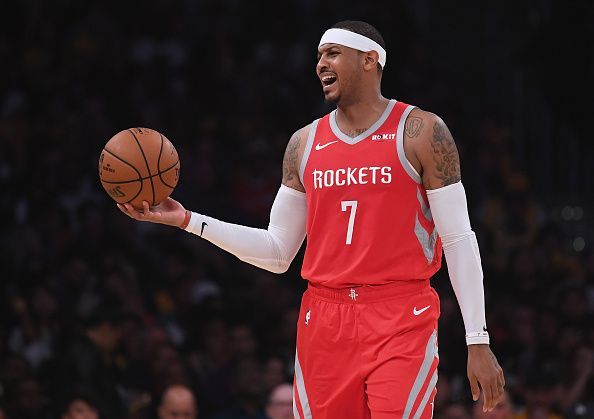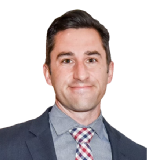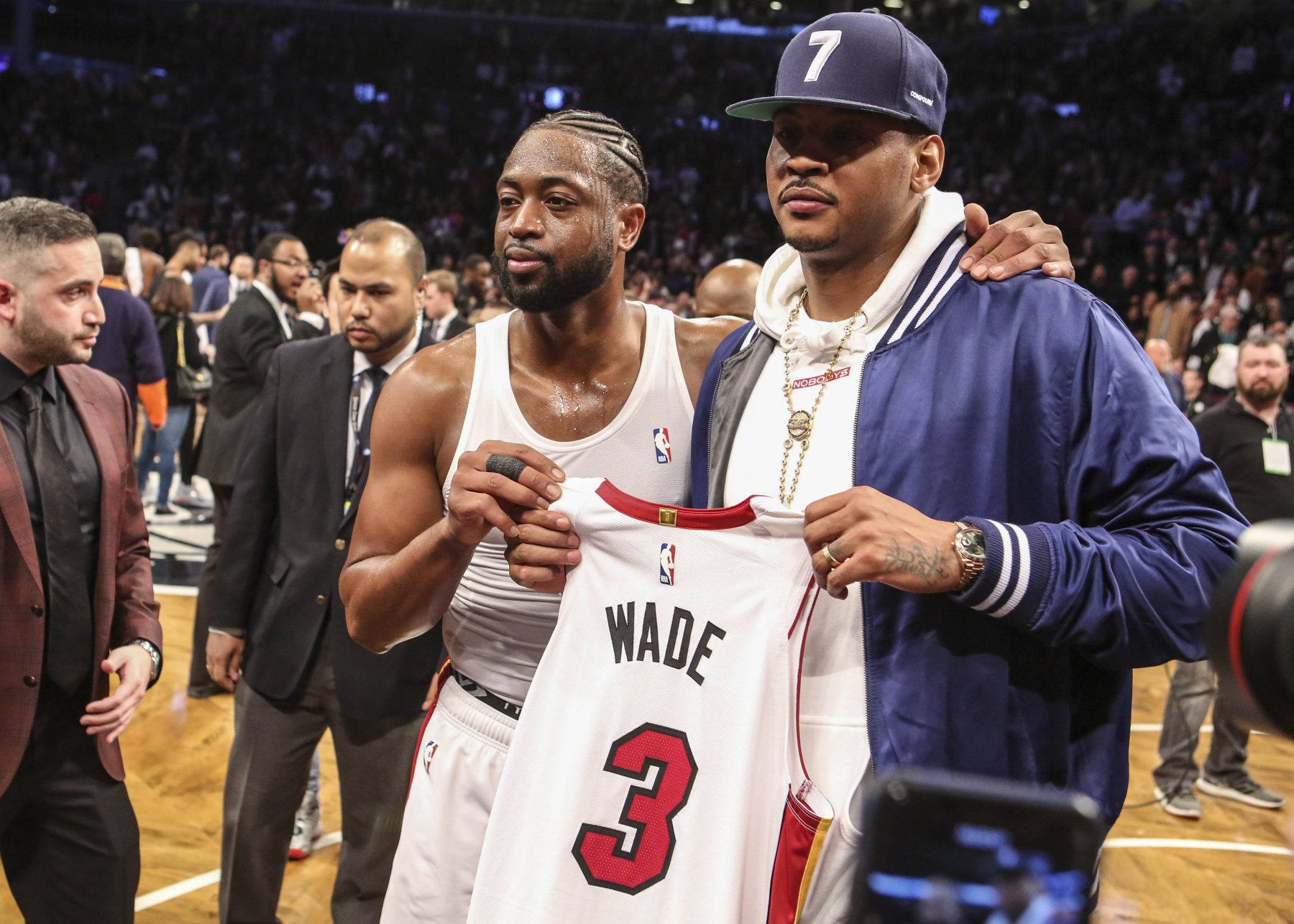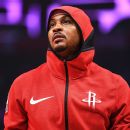
The burnout of the shooting star Carmelo Anthony

- Baxter HolmesESPN Senior Writer
The corner.
For a volume midrange shooter -- a man considered the antithesis of the analytics movement that has revolutionized the NBA -- Anthony is about to take what that very movement has roundly declared to be basketball's most efficient and valuable shot: a corner 3-pointer.
Up to this point in the game, all 10 of Anthony's attempts have failed to reach the bottom of the net; his last resulted in a basket only because of a favorable goaltending call. Five of those shots were from beyond the arc. Also present in Oklahoma City, where his team now trails by 22 points, is Rockets general manager Daryl Morey, who in some 24 hours will meet with Anthony in a hotel room in San Antonio. Morey will tell Anthony -- who was expecting to play the next day against the Spurs -- that the Rockets, after just 10 games, no longer need his services.
play
0:18
Melo grabs offensive board, misses 3
Carmelo Anthony grabs an offensive rebound, but he misses his 3-point attempt against the Thunder in a November 2018 matchup.
After that, Anthony will spend the rest of the season on the sidelines as NBA players profess their love for him on social media and in interviews, all but demanding that Anthony, who turned 35 in May, belongs among the 450 players in the league. This cycle will continue into the summer, a chorus growing louder as the future Hall of Famer -- a 10-time All-Star -- remains untethered to any team. Other reclamation projects -- including enigmatic center Dwight Howard and 38-year-old wing Joe Johnson -- are expected to make NBA rosters. Anthony will even go on national television -- on ESPN -- and campaign for a different ending.
"I feel like I still can play," Anthony tells Stephen A. Smith. "I know I still can play."
In this moment, though, that is all in Carmelo Anthony's future. On this day, he is still 34, still in the league, still in a game, with the ball in his hands. As he's done 20,360 times before, he lets it fly. He has taken many shots that now measure as poor, because he came up playing a style that his heroes did before him, but this shot is quantifiably defensible. Ironic, then, that this one caroms off the back of the rim, giving him two points on 1-of-11 shooting while a national television audience looks on. A timeout is called two seconds later. He checks out of the game. He does not come back in.
After a 98-80 loss drops Houston to 4-6 on the season, Anthony boards the Rockets' charter plane. It lifts into the chilly Oklahoma City sky toward south Texas as a waxing crescent moon hangs above. Several staffers aboard have no idea that they just witnessed Anthony's last game. He has no idea he's just played in it. There is tomorrow, another game. Anthony doesn't know that it's over.
AFTER THE TIMEOUT is called but before he checks out of the game, Anthony lingers on the court at Chesapeake Energy Arena, giving a long look to the Thunder's bench. One season earlier, on the late-September 2017 day that the Thunder had introduced Anthony, he had been asked about coming off that very bench after starting every game in his career. Sitting in his introductory news conference, he'd worn a hoodie, his arms crossed. He'd leaned forward into the microphone, a smile breaking across his face.
"Who, me?"
That sound bite would be amplified when, in his exit interviews after a disappointing season in Oklahoma City, Anthony was asked a similar question. "Yeah, I'm not sacrificing no bench role, so you can -- that's out of the question." And so the narrative went: an aging star who couldn't let go of the stature he had enjoyed, undone by his unwillingness to let go of what was ultimately holding him back.

A wild summer in the NBA will make for an exciting 2019-20 fantasy hoops season. Create or join an ESPN Fantasy Basketball league today! Sign up for free!
Anthony declined to participate for this story, and his representatives directed comment to previous interviews. But many people close to him and inside and around the organizations where he has played were willing to discuss his swift demise. "His name is a blessing and a curse," says one source close to Anthony.
"And it's more of a curse right now."
Anthony's headlong dive into basketball exile is partly the story of the game's dramatic evolution that placed him on the wrong side of history. But it's also partly the story about the pratfalls of greatness -- and how stars often decline as steeply as they rise to dominance.
"When you're one of the top 10 players in our league for 10 years, you think it's going to be there forever," says one of Anthony's former NBA coaches.
"They're always the last ones to know."
THE WARNING SIGNS first arrive in southwest Louisiana, where the Rockets have gathered for training camp at a complex in Lake Charles. It's late September of 2018, and after years of fawning over Carmelo Anthony, the Rockets finally have him. Team officials believe that his offensive punch will compensate for the loss of long-range shooter Ryan Anderson, whom they traded the month before. They believe that Anthony, with a fresh start, can bounce back from a poor season in Oklahoma City.
Which is not to say there aren't concerns. There's concern among some coaching staff members and others in the organization about the dynamic between Anthony and Rockets coach Mike D'Antoni; the two had had a fractured history during their time together with the Knicks a few years earlier. There's concern that Anthony, a midrange jump-shooter, will struggle within the Rockets' analytically driven offense, one predicated on 3-pointers, free throws and shots around the rim.

But the Rockets are ultimately confident in D'Antoni's system. They believe that it can accentuate the positives and minimize the negatives from a player's skill set -- not just Anthony's but any player's. The approach is risky. But under Morey, the Rockets are nothing if not aggressive. They're trying to hit a home run.
As one team source says: "We needed scoring."
In talks with Anthony, team sources say, his role was explained: He would be coming off the bench. Those sources also say Anthony embraced this role, was nothing if not professional and understood his fit on a roster that featured reigning MVP James Harden and Chris Paul and had ambitions of a deep playoff run after winning 65 games the season before and falling one win shy of the NBA Finals.
During training camp in Louisiana, though, another issue arises, one that some Rockets officials say they hadn't fully grasped until they saw Melo on the court: The 34-year-old is struggling in the team's defensive scheme, one that requires players to switch often on pick-and-roll action. (According to Second Spectrum data, the Rockets switched on 44% of screens last season, by far the highest in the NBA. The Warriors were second at 33%. No other team was above 25%.)
That Anthony was a subpar defender wasn't breaking news to anyone, but then the NBA's style of play changed -- in a big way.
NBA Rooks[/paste:font]

Follow Zion, Ja, RJ, De'Andre, Coby and more top rooks as they balance basketball and life during an exciting NBA season. Watch on ESPN+
Three months after he last suited up, Anthony heads to Charlotte for a star-studded dinner at the All-Star Game to honor Heat star Dwyane Wade in the midst of a farewell tour in his 16th and final season. At the gathering, many NBA stars of past and present toast Wade, who sits in a throne-like chair. When it's his turn, Anthony references how they've known each other since college, how they're like family.
"One of the realest conversations that I had with you in 16 years was when you told me you were about to retire," Anthony says. "I said, 'Hell no.' I said, 'You can't go out like that.' Now look at you."
In this moment, Anthony is 34; Wade is 37. A league source present at the gathering said Anthony's words seemed genuine in showing love to a dear friend and in no way envious of the farewell tour that Wade is enjoying. Because, the source says, as everyone honored the 2006 Finals MVP, Anthony didn't yet believe his NBA career was over. He thought he'd still be picked up by a team -- soon.
"IT'S ABOUT THE right fit," Wade says. "The toughest part -- for GMs, presidents, owners and players -- is how to handle an aging superstar in this game. It has to all work perfectly. Everyone has to make the right sacrifices, has to be the right group and coach. It has to work perfectly when it's an aging star in this game."
It's a few weeks before last season's All-Star Game, and Wade is speaking to reporters in New York before the Heat play the Knicks. Sitting courtside is Anthony, who by now has been let go by the Rockets. A few months from now, Wade will play his final NBA game, this one in Brooklyn, and again Anthony, who remains unsigned, will be in attendance. At one point midway through the fourth quarter, the ball will bounce toward Anthony, sitting courtside in street clothes. He'll grab it and pretend as if he'll shoot it, but he doesn't. The crowd roars. The clip goes viral. After the game, Wade presents his jersey to Anthony, and the two longtime friends and members of the 2003 NBA draft class share a long embrace.

Carmelo Anthony was present at many of Dwyane Wade's biggest moments during his longtime friend's final season. Brad Penner/USA TODAY Sports
The end -- and the reckoning that comes with it -- is often brutal, all the more so because it plays out on a public stage. And so on many recent summer days in New York City, onlookers line up outside the tall glass windows peering down into a full-length basketball court near the corner of 11th Avenue and 42nd Street in Hell's Kitchen. They've told the front desk at the luxury apartment complex that they're considering a membership to the Lifetime Athletic Sky gym and just want to look around, but staffers know better. They know that the curious are really just there to watch the pickup games they've seen go viral on Instagram, featuring a who's-who of NBA superstars: Harden, Russell Westbrook, Kevin Durant, LeBron James, C.J. McCollum.
And it's here that these onlookers see Carmelo Anthony play.
They don't see the Carmelo Anthony they likely remember best, for that version could last be found a mile away and six years ago, during the 2012-13 season. Back then, Anthony was 28, a seven-time All-Star in his second full season with the Knicks. And that year, something unusual happened for the Knicks: They caught fire. But the reason they did so would speak to Anthony's impending struggle to fit into a changing league that would ultimately leave him behind.
Anthony, several members of those Knicks say now, had always envisioned himself as a small forward; he'd stubbornly preferred to play that position, even though members of the coaching staff and front office say they had long viewed him as a stretch power forward who could space the court with his shooting. But Knicks insiders say that ownership -- namely Jim Dolan -- wanted Anthony to play the small forward position while A'mare Stoudemire played power forward. This frustrated some members of the coaching staff, who viewed it as driven only by Dolan's desire to have star power on the court, according to sources on those Knicks teams. But in 2012-13, Stoudemire was sidelined for most of the season with knee trouble. To accommodate, Anthony agreed to change positions. "The injury that year forced everyone's hands -- Jim's and Carmelo's," one Knicks source says.


 I don’t really see the conspiracy here
I don’t really see the conspiracy here